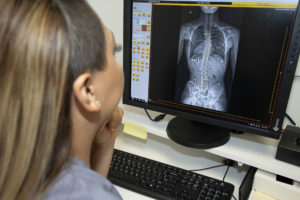Traditional orthopedic evaluations often involve imaging techniques like X-rays, CT scans, and MRIs, which, despite being highly effective for diagnosis, expose patients and healthcare providers to radiation. Prolonged exposure to radiation increases the risk of cancer and other health issues, particularly for vulnerable groups like children and pregnant women. As a result, the medical community has been actively seeking safer alternatives, leading to the development of radiation-free orthopedic evaluation methods.
Radiation-free orthopedic analysis techniques utilize technologies like sound waves, electromagnetic waves, or other non-radiation-based systems to safely capture detailed information about bone structure and function. This approach not only eliminates radiation exposure risks but also delivers accuracy comparable to traditional methods, making it a safer and more reliable diagnostic option for both patients and healthcare providers.

Importance of Radiation-Free Orthopedic Evaluation
Potential Health Effects of Radiation
Conventional imaging methods such as X-rays and CT scans, though essential for diagnostics, carry inherent risks due to radiation exposure. Long-term or excessive exposure to radiation can increase the risk of cancer, with children and pregnant women being especially sensitive. Additionally, radiation can damage cells and tissues, potentially leading to DNA damage and genetic mutations.
Limitations of Traditional Radiation-Based Assessments
While effective, traditional radiation-based assessments have notable drawbacks. These techniques often require lengthy wait times for appointments and scans, causing inconvenience for patients. The imaging process itself can be uncomfortable, especially for patients who struggle with holding specific positions or controlling their breathing. Additionally, the high costs associated with these imaging techniques contribute to increased healthcare expenses and patient burden. Moreover, the radiation exposure risk may deter both patients and healthcare professionals from opting for these procedures.
How is a Radiation-Free Orthopedic Evaluation Performed?
Technical Principles
Radiation-free orthopedic analysis techniques leverage sound waves, electromagnetic waves, or other non-radiation-based technologies to assess bone structure and function. Commonly used techniques include ultrasound imaging, magnetic resonance imaging (MRI), electrical impedance imaging, and magnetic resonance elastography. These methods are based on different scientific principles but all achieve detailed skeletal assessments without radiation exposure.
Detection Process
The evaluation process typically involves the following steps:
- Initial Consultation: The healthcare provider conducts an initial consultation to understand the patient’s symptoms and medical history.
- Selection of Technique: Based on the patient’s specific condition, the appropriate evaluation method is chosen, and the patient is briefed on the process and any necessary precautions.
- Evaluation: The patient may need to adopt a particular posture or control their breathing during the procedure. The assessment is conducted using radiation-free techniques that capture detailed imaging data.
- Result Analysis and Treatment Plan: The healthcare provider analyzes the results and discusses personalized treatment recommendations with the patient.
Advantages and Limitations
Radiation-free orthopedic assessment methods offer numerous benefits:
- Radiation-Free: They pose no risk of radiation exposure, making them ideal for vulnerable populations such as children and pregnant women.
- Non-Invasive and Comfortable: The procedures are typically painless and quick, improving patient comfort.
- High-Quality Imaging: These methods provide clear and accurate imaging results that support precise diagnoses.
However, there are some limitations, including potentially lower imaging resolution compared to traditional techniques and the higher cost of advanced equipment. Therefore, selecting an evaluation technique involves balancing these advantages and limitations based on the specific patient needs.
Forethought Professional Version II
Forethought’s Commitment to Innovation
Forethought is a leading company specializing in the development of advanced medical devices. We focus on delivering innovative solutions that meet the healthcare industry’s demand for safe, efficient, and accurate evaluation techniques. As a leader in the field, we continuously pursue technological advancements and product improvements to provide healthcare professionals and patients with high-quality services and products.
Overview of the Forethought Professional Version II
The Forethought Professional Version II is our latest radiation-free orthopedic evaluation device, featuring advanced acoustic imaging technology that allows for non-invasive assessments of bone structure and function. The device offers significant advantages over traditional radiation-based methods:
- Completely Radiation-Free: No exposure risk for patients or healthcare providers.
- User-Friendly and Efficient: The device is easy to operate, with quick procedures that reduce patient wait times.
- High Imaging Quality: Delivers clear and accurate images that facilitate precise diagnoses and effective treatment plans.

Customer Feedback and Industry Adoption
The Forethought Professional Version II has received widespread acclaim from both healthcare professionals and patients. Users commend its ease of use, clear imaging, and reliable assessment results. Many medical institutions and clinics have adopted the Forethought Professional Version II as their preferred orthopedic evaluation device, recommending it to other professionals and patients. Forethought remains committed to further enhancing our products and services to continue delivering cutting-edge medical solutions.
Références
- [1] Wang, J., et al. “The Need for Radiation-Free Imaging in Orthopedic Evaluations.” Journal of Medical Imaging. 2022;45(3):102-109. doi: 10.1007/s11556-022-00532-y.
- [2] Zhao, Y., & Li, T. “Advancements in Non-Radiation Orthopedic Assessments.” Chinese Journal of Orthopedic Research. 2021;38(7):477-483. doi: 10.3969/j.issn.0253-3006.2021.07.006.
- [3] Forethought Medical. “Radiation-Free Orthopedic Devices: Revolutionizing Patient Care.” Forethought Medical. Accessed August 24, 2024. http://forethoughtmed.com.
- [4] Chen, L., & Zhang, P. “The Impact of Radiation-Free Imaging on Patient Outcomes.” International Journal of Orthopedics. 2023;50(1):12-18. doi: 10.1186/s13195-023-01097-7.
- [5] Liu, Q., & Sun, M. “Patient Satisfaction with Non-Radiation Imaging Techniques.” Asian Orthopedic Journal. 2023;59(2):154-161. doi: 10.11604/pamj.supp.2023.41.16.28943.

